Dominican Republic: Coping with the Officialdom of Cruising
Having crossed the Atlantic Ocean on their fossil fuel free vessel “Ya”, Inge van Berkel and Peter Hoefnagel explored several Caribbean islands and countries on their way to Panama. Here they report on cruising the Dominican Republic after a short stop in Martinique.
Published 2 years ago
Martinique
We anchored in the lovely bay of Anse Chaudiere/les Anses D’Arles. We tried to find the place with the computer for registration, several times but it was always closed. Nobody seemed to be really interested or worried.
We enjoyed our short stay and as we had listed ‘La Romana, Dominican Republic’ on our exit-Zarpe from Columbia we set sail without further delay.

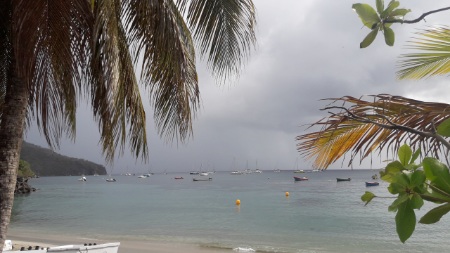
- Martinique anchorage (c) SY Ya
Dominican Republic (DR)
We arrived at La Romana at night. Navigation was easy. We anchored in front of the immigration/customs building, some 100 meters from the west bank, close to the dock (for your dinghy). The officials gave us directions we could not really understand, but if you anchor pretty close to the bridge it is OK. They asked for our Despacho right away and after a small discussion we agreed to come to their office in the morning.
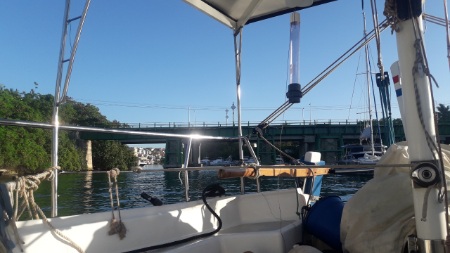

It is allowed to anchor there, but it is not very comfortable with many passing boats. Good holding ground with little tidal current and an ebb stream of 2 knots maximum.
The formalities took two hours, officials were very friendly and the customs officer even gave us ride to the ATM. We paid:
- 1,200 DRP for the port authorities (aviso de LLegada),
- 4,000 DRP for immigration (for the boat and 2 persons)
- 1,200 DRP for the ‘armada’ (no receipt)
So, in total some 110-120 USD. It is only when leaving the DR, that you need an international Despacho and this costs another 20USD.
They advised us that the ‘Despacho’ is mandatory for each movement between harbors within the DR, but it is free of charge.
Try to always arrive much earlier than 5 PM at the office to get your Despacho. If you are later, they will most probably forbid you to depart, so you have to try again the next morning. Why do they forbid you to leave after 6 PM? Because they think no one can navigate in the dark. And, according to the Armada, it is dark from 6 PM! We got our Despacho for Bayahibe within an hour.
Good provisioning at the enormous (and rather expensive) supermarket; fruit and vegetables are cheaper on the street/the market.
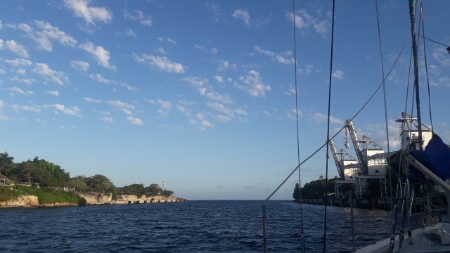

Bayahibe
Bayahibe is busy with about 100 tourist boats visiting daily. Be careful of the shallow places, but they are well marked with buoys and seem to be (dead) coral and stone. Other than that there are plenty of sandy spots providing good holding.
We arrived late in the afternoon so we decided to do our Despacho/report procedure the next morning. In the morning (around 6am), we were woken by a boat hitting our side – it was the Armada wanting to see our Despacho. They approached us in a fisherman’s boat, six men, a mix of officials, armed men and fishermen. Unfortunately, their boat kept banking against ours, which was most unpleasant. However, a little paint will repair the damage. Some Spanish does come in handy with all the shouting going on. Sleepily, we showed them the Despacho which was all they wanted to see.

However, they told us that we had to come to their office during opening hours so they could see the Despacho again. So we did but the official was not there so we had to wait 1.5 hours to officially ‘check in’. They took our Despacho, so we were glad we had taken a picture of it.
To get the Despacho to go to Rio Cumayasa took another 1.5 hours of waiting and the hassle of ‘no, we have not got your Zarpe’, ‘yes you do, here is the picture’ etcetera. Just stay polite and friendly, you will get your Despacho in the end.
Rio Cumaysa
First the red tape. On your port side there is the Armada-office but getting there is not easy because there is a lot of swell which comes in and hits the docks. We would advise against landing at their dock, because it is too dangerous to land your dinghy there and climb out.
Instead, go to the neighbouring concrete pontoon which is 50 metres to your left. This large pontoon breaks the waves better and on the lee side, it is a bit more sheltered. There is a big rubber tyre to climb onto the dock. We were told the owner of this pontoon is never there so you can walk through the fenced gate to the street and from there turn right to get to the Armada office. The officials don’t seem to have much to do but even so, the procedure takes a while.

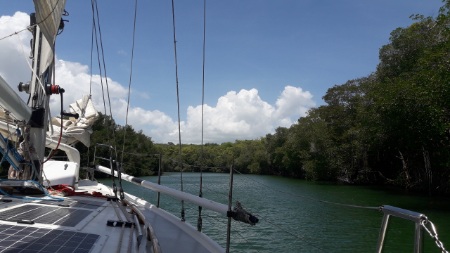
- Anchorage in Rio Cumaysa (c) SY Ya
Navigation on the river:
There’s a shallow spot that’s not on Navionics – (18 24.331 N, 69 5.1 W). A provisional buoy marks the top of the shoal. Make a wide turn. When you go upriver, there’s lots of small harbors and hurricane holes, where some owners seem to have forgotten their boats. A weird sight but the river is really beautiful, especially further upstream.
The current is not more than two knots and the river is 1.5 meters deep from 18 25.2541 N and 69 05.2054’ W.
It takes about one to 1.5 hours for it to get your Despacho when you want to leave.
Santo Domingo, Marina s. Bartolomeu:
Don’t enter at night and call in advance because the authorities need to open a floating line (which closes off the harbour for debris) for you to come in. Berthing was not easy with the wind and without bow thrust, because they want you to first attach a stern line to the shore. It took some time before the mariners in the RIB at the mooring buoy were willing to attach the bow-line to the mooring.

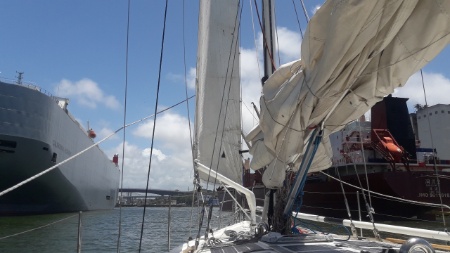
- Santo Domingo anchorage (c) SY Ya
The harbor is tiny, the staff are friendly, showers are so-so, the water is not potable, the electricity varies from 90Volt to 110 and the wiring is doubtful. But again, the staff are willing to solve any problem.
The marina is near the city centre which is really worth a visit, really nice museums (we saw Atarazes, Amber, Larimar and the Palacio de Colon). It’s also lovely just walking around within the city walls and there’s a really good laundry here too.

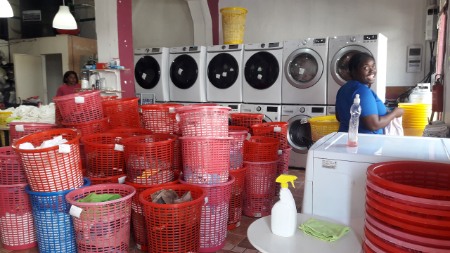
- Excellent laundry (lavandaria) (c) SY Ya
Marina Staff coordinate the officials for the Despacho handling (they come from the other side of the river), which is very nice of them, but again, allow at least an hour to have your Despacho checked on arrival and and again when departing.
Barahona
Club Nautico is a funny place. It’s a restaurant with a tiny harbour and lots of locals. You are supposed to anchor in the bay and while you don’t have to pay, it is appreciated if you have some dinner/lunch at the club. The food is good (also price/quality) so that’s easy. The manager makes sure that Ivan from immigration is present when you arrive. Ivan is everywhere and knows everything, don’t be surprised if he is also your taxi-driver.
Sometimes a big ship comes in and then you must leave the sheltered harbor near Club Nautico. We did not mind because there were a lot of mosquitos there. So actually, in front of the Armada building we found it more pleasant: a bit more rolly, but also more wind and out of the reach for the Sargassum-weed beaching.
We payed Ivan the standard fee of 20 dollars for the international Despacho / exit-Zarpe and the process went very smoothly.

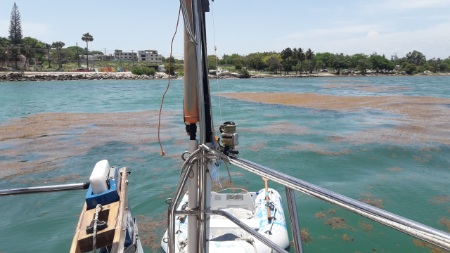
- Sagassum weed floating in the anchorage. (c) SY Ya
Isla Beata
Unforseen circumstances meant we had to anchor here, so we did it in front of the Armada. It is not possible to clear in our out here. The commandante was very friendly and let us stay on anchor for the night. He must have warned the officials because again a fishing boat hit our boat, giving us another few scratches. Two officials took pictures of our Despacho and left.
Baia Aguila
A truly beautiful beach, clean, quiet and pristine. No Sargassum weed, but good internet coverage – a rare combination. We stayed a few days. On the day we left, the Armada came by with two officials who, of course, wanted to see the Despacho. We showed the document and they were happy.
Inge van Berkel and Peter Hoefnagels
SY The Ya
………………………………………………………………………………………………………………………………………
About the Authors

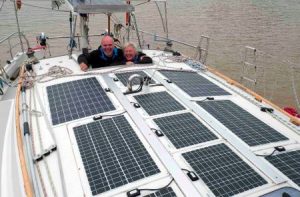
- Inge and Peter in the cockpit of “The Ya”
Peter Hoefnagels and Inge van Berkel are sailing around the world without using fossil fuels. No diesel, no gas, no petrol. On-board life is energy neutral and very comfortable. Says Inge: Sustainable cruising means sailing globally, living locally. We buy, eat, live and act where we anchor. With the locals we exchange information and methods about sustainability and living self supporting. Whatever we learn from them, we share with you on our blog. In exchange, we deliver a clean wave in all corners of the globe.
……………………………………………………………………………………………………………………………………
SY Ya Blogs
https://fossilfreearoundtheworld.org/coral-reef-in-the-dominican-republic/
Adventures in Barahona:
https://fossilfreearoundtheworld.org/larimar-the-spirit-of-the-caribbean/
https://fossilfreearoundtheworld.org/live-and-let-live-on-the-market/
Isla Beate
https://fossilfreearoundtheworld.org/isla-beata/
Related Links about SY Ya:
- Gambia: A Great Place for Sailors (Noonsite January 2022)
- Gambia: Skirting the Covid Chaos (Feb, 2021)
- Ya: The Yacht That Sailed the World Fossil Fuel Free
- Fossil Free Around the World Website
Other Related Links:
…………………………………………………………………………………………………………………………………..
The opinions expressed in this article are the author’s own and do not reflect the view of Noonsite.com or World Cruising Club.
………………………………………………………………………………………………………………………………………
Find out all news, reports, links and comments posted on Noonsite, plus cruising information from around the world, by subscribing to our FREE monthly newsletter. Go to https://noonsite.wccstaging.com/newsletter/.
Related to following destinations: Barahona, Dominican Republic, Martinique
Related to the following Cruising Resources: Caribbean Sea, Circumnavigation, Routing


